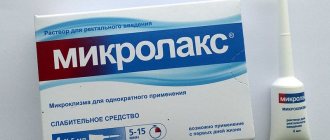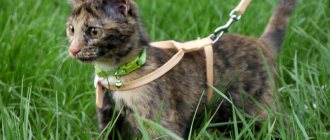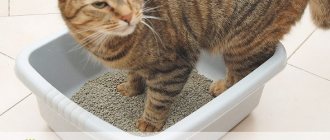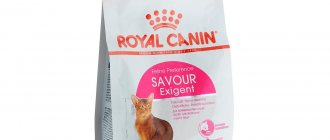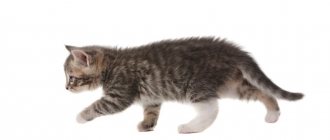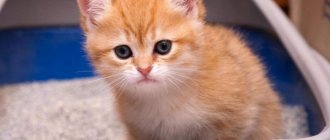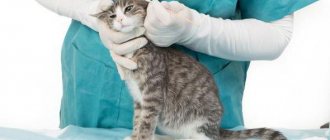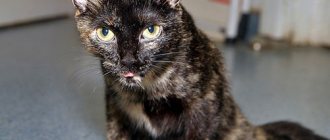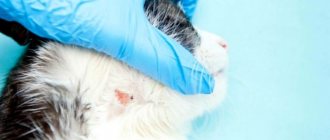- Posted by Olesya Vakhraneva
- Date: October 18, 2018
If the need to clean your cat's litter box does not come at the right time, she may be constipated. A caring owner will want to help the pet, and to do this, it is necessary to identify and eliminate the factors that led to the problem. You should also take a closer look at the animal, since constipation is often a symptom of internal diseases.
- 2 Causes of constipation in cats
- 3 Consequences of long-term and chronic constipation
- 4 Helping a cat with constipation
4.1 Pharmacy laxatives
4.1.1 Table: overview of pharmaceutical laxatives
- 4.4.1 Video: cat enema at home
- 4.5.1 Video: help with constipation for a kitten
How does constipation manifest in cats?
Constipation in cats is a condition characterized by prolonged retention of feces in the intestines. It is always accompanied by difficult or absent bowel movements. On average, a healthy cat visits the litter box for “big business” once a day, a growing cat with a faster metabolism twice a day, and an older cat once every two days. When cats have stool retention for 3 days, measures should be taken.
Additionally, constipation is accompanied by the following symptoms:
- obvious difficulties and pain in the cat when trying to recover;
- bloating due to gas retention;
- vomiting (sometimes);
- general depressed state, lethargy;
- anorexia (the animal does not eat or drink water);
- slightly swollen anal area;
- altered stool character: excrement looks dry, even cracked, sometimes with a small amount of liquid feces, foreign matter and an admixture of fresh blood on its surface.
A cat's lack of stool for three days requires intervention.
Storage requirements
The effectiveness of the drug Duphalac remains subject to proper storage conditions and until the expiration date of the drug. After three years have passed from the production date indicated on the bottle and packaging, the medicine should be thrown away. The product should be stored in a place where children and pets cannot access it. This could be a lockable first aid kit or a securely closed desk drawer designed for storing medications. Storage temperature is not higher than 25°C. Before giving medicine to an animal, you should perform a visual inspection and evaluate the smell. If the product has changed color to brown or dark gray, and also acquired a sour smell, the medication is hopelessly spoiled and must be disposed of.
Causes of constipation in cats
The causes of constipation can be caused by two groups of factors:
- external - diet, maintenance features;
- internal - when constipation is a symptom of some cat disease.
External factors that provoke the development of constipation are the following:
- deficiency of fiber as the main ballast substance in the cat’s diet;
- overeating or feeding the cat in too small portions, for example, for weight loss - in both cases, the passage of food through the intestines is disrupted;
- lack of free access to drinking water, especially when using dry food;
- obesity, lack of physical activity;
- getting a large amount of hair into the cat’s intestines during self-licking, especially during shedding;
- the use of certain medications (long-term or in high doses) - iron, astringents, antispasmodics, anticholinergics, antihistamines;
- ingestion of bones, toys;
- the presence of roughage in the cat’s diet - meat bones, a large amount of cartilage;
- stress - moving, change of owner, appearance of another pet;
- undergone surgery.
Constipation may occur in a cat if there are the following diseases:
- chronic renal failure;
- helminthic infestations;
- diabetes mellitus;
- intestinal tumors;
- injuries of the spine and pelvic area;
- neurological diseases;
- megacolon - a congenital pathology of the large intestine (expansion and elongation), leading to disruption of the movement of food through the intestines and retention of fecal matter;
- prostate cysts or neoplasms;
- various pathologies of the liver and pancreas, chronic colitis and gastritis and other diseases.
The use of a laxative is necessary both to combat constipation and to prevent its consequences
Under the guise of simple constipation, an acute surgical condition may be hidden, for example, intestinal obstruction, formed by blocking the intestinal lumen with a tumor or foreign body. Its manifestations:
- the cat is restless, tries to take a forced position, wants to drink, but at the same time refuses to eat;
- the stomach is usually tense, swollen and painful;
- vomiting is possible, sometimes with blood, as well as the appearance of liquid bloody discharge from the anus;
- increased body temperature;
- shallow breathing of the cat, rapid pulse.
If constipation is accompanied by the symptoms described above, it is necessary to exclude the development of acute surgical pathology. In this case, you should not give the cat a laxative, nor should you feed and water it until examined by a doctor.
What to give to cats suffering from diabetes
Preparations containing lactulose (Duphalac, Lactusan) should not be given to cats suffering from diabetes.
For such animals it is recommended to apply:
- Sodium picosulfate . The drug causes strong rhythmic contractions of the muscles of the colon. This remedy is usually prescribed to cats after sterilization, when it is undesirable for the animal to push too hard. The dosage and frequency of taking the medication is determined by the veterinarian.
- Nux Vomica-Homaccord . The medicine is used to eliminate hairballs from the body naturally. The product contains substances that soften and lubricate the furball, as well as vitamins that help strengthen the coat.
- Magnesium sulfate . A single dose for an adult cat is half a packet of powder. It is diluted in water and injected into the pet’s cheek using a syringe without a needle.
For pets with diabetes, you can also use herbal medicine and other homemade laxatives that do not affect metabolic processes.
Laxatives help normalize the cat's digestive process and metabolism. All laxative medications have certain contraindications and should only be used after consultation with a veterinarian.
Consequences of long-term and chronic constipation
Constipation that persists for more than three days can cause the following consequences:
- development of general intoxication;
- dysfunction of internal organs, especially the liver and kidneys;
- rupture of the intestine with the development of peritonitis;
- increased load on the heart.
Consequences characteristic of chronic constipation:
- development of imbalance of intestinal microflora (predominance of putrefactive bacteria), secondary colitis;
- disruption of the synthesis of certain vitamins: B12, biotin, folic acid;
- deterioration in the condition of the coat - the coat becomes dull and may fall out;
- increased load on liver and kidney function due to toxic nitrogenous compounds released by putrefactive bacteria;
- proctitis, paraproctitis, rectal fissure;
- acquired megacolon;
- the development of malignant neoplasms of the large intestine is the most serious consequence.
The occurrence of complications significantly worsens the course and prognosis of the disease.
Helping a cat with constipation
In most cases, it is possible to eliminate constipation in a cat by using laxatives. You can treat your pet yourself when the cause of constipation is obvious. In all other situations, especially if the cat has other diseases and is already receiving drug therapy, you should consult a veterinarian. For example, you cannot give a laxative to an animal with chronic renal failure and dehydration: first, a drip is prescribed to eliminate fluid deficiency in the body.
Pharmacy laxatives
The following medications are used to treat a cat for constipation:
- Based on lactulose. In a regular pharmacy you can buy laxatives Duphalac, Lactusan, Prelax and others, in a veterinary - Vetelakt. Lactulose-based products are distinguished by their mild action and high safety. All of them contain lactobacilli, therefore, they are prebiotics - they thin the stool and increase its volume. They are also suitable for use for chronic constipation.
Lactulose-based laxatives are used to treat constipation in cats.
- Based on sodium picosulfate (Guttalax, Laxigal, Slabilen and others) and magnesium sulfate (an emergency remedy for severe constipation). They actively stimulate peristalsis and cause noticeable cramping pain in the cat’s abdomen. Exceeding their dosage is fraught with the development of dehydration: they greatly dilute feces, sometimes the cat does not have time to reach the tray. Laxatives of this group are prescribed by a veterinarian taking into account the general clinical picture.
Laxatives based on sodium picosulfate and magnesium sulfate are quite strong drugs that are prescribed by a veterinarian
Table: overview of pharmaceutical laxatives
| A drug | Lactusan | Duphalac | Prelax | Vetelakt | Guttalax | Laxigal | Weak | Magnesium sulfate |
| Compound | At least 55% dry matter, of which:
| Lactulose - 66.7 g/ml. |
|
| Sodium picosulfate monohydrate per 100 ml - 0.75 g. | Sodium picosulfate - 7.5 mg per 1 ml. | Sodium picosulfate - 7.5 mg per 1 ml. | 100% magnesium sulfate. |
| Release form |
|
| Syrup in bottles of 1000, 400, 220, 100 ml. |
| Drops for oral administration 15 or 30 ml. | Drops for oral administration in bottles of 10 or 25 ml. | Drops for oral administration in bottles of 15 or 30 ml. | Packets of powder for preparing a solution for oral administration, 10, 20 or 25 g each. |
| Mechanism of action |
The effect occurs within 2–3 days. | Under the influence of intestinal microflora, an active substance is released, stimulating the receptors of the intestinal mucosa and causing increased peristalsis. The effect occurs within 6–12 hours. |
The onset of action is 0.5–3 hours, duration is 4–6 hours. | |||||
| Indications |
|
|
| |||||
| Contraindications |
|
|
| |||||
| Dosing | 0.5 ml of the drug per kg of animal weight in 2 doses per day. | 1 drop per 2 kg of body weight, preferably at night. Not used in animals weighing less than 2 kg | Dilute 3–10 grams in water and drink from a syringe. The taste is disgusting, you should prepare for active resistance from the cat. | |||||
| Side effect | In the first days of taking it, intestinal flatulence may develop, which goes away on its own within three days. In case of overdose - nausea, abdominal pain, diarrhea. | Possible diarrhea, accompanied by dehydration and loss of electrolytes with manifestations of arterial hypotension and seizures |
| |||||
| Possibility of use in pregnant cats and kittens | Yes |
| Use during pregnancy with caution, when the benefit to the cat outweighs the risk to the pregnancy. Do not use during lactation. There are no contraindications for use in kittens, but it is better not to do this, since milder means are available | |||||
| Price |
|
|
| 20 ml - 117 rubles. |
| 25 ml - 267 rub. | 15 ml - 156 rub. | 20 grams - 20 rubles. |
Traditional methods of treatment
Possible application:
- Vaseline oil. It is added to liquid food 3 times a day at a dosage of 2–3 ml per kilogram of the cat’s weight. Vaseline oil softens excrement and has an enveloping effect, facilitating its removal without significantly liquefying it. This is one of the best ways to combat constipation in animals.
- A drink made from condensed milk and raw water. The components are randomly mixed and offered to the cat. This product should not be given to an animal diagnosed with pancreatitis.
- Senna (cassia) leaves. Pour dry raw materials (3 - 5 grams) with a small volume of hot water, convenient for drinking a cat (about 10 - 25 ml), leave in a water bath for 30 minutes, then cool at room temperature, filter and give to the animal. This is a mild laxative, acceptable when the cat’s stool is independent, but difficult.
Senna leaves are an effective folk remedy for treating constipation in cats.
- Any vegetable oil (almond, flaxseed, olive) - 1 teaspoon 2 times a day. The method should not be used on a regular basis, since oils are involved in the cat’s metabolic processes, and their excess creates an increased load on the liver.
- Kefira. Add a teaspoon of vegetable oil to half a glass of drink. This is a mild laxative.
What to do if you can’t cope with constipation at home
In rare situations, constipation requires additional examination and treatment of the cat in a hospital setting. First of all, the doctor needs to understand whether it is really constipation, as well as its cause. The examination in the clinic usually consists of:
- general blood test;
- general urinalysis;
- biochemical blood test;
- plain radiography of the abdominal cavity to determine fluid levels characteristic of intestinal obstruction, as well as ingested foreign bodies;
- series of photographs with contrast passage (barium sulfate) - if necessary;
- Ultrasound of the abdominal organs.
After examining the cat, the veterinarian may decide on deep intestinal lavage or surgical treatment - removal of fecal stones or a section of the affected intestine with megacolon.
In some situations, treatment of constipation must be continued in a clinic setting.
Cleansing enema for cats
The advisability of an intestinal enema in a cat should be discussed with the attending veterinarian. The animal must be restrained and held securely. Boiled water is used, approaching the cat’s body temperature, you can add a teaspoon of petroleum jelly. An adult animal requires 50–100 ml of water; in the case of a kitten, the doctor will indicate the volume. The procedure is carried out as follows:
- The tip of the rubber bulb is generously lubricated with Vaseline oil and inserted with rotational movements to a depth of 2 cm into the anus of a cat lying on its side (for a kitten - no more than 1 cm).
- By pressing on the pear, they introduce its contents into the cat’s intestines, after which they press the tail against the anus and hold it there for about five minutes. You can gently massage her belly.
The effect of the enema is expected within 15–30 minutes.
Video: cat enema at home
Features of the use of laxatives in kittens and pregnant cats
Constipation in a kitten is best treated with Vaseline oil - 0.5 ml 3 times a day. If it is due to the inexperience of the cat mother and improper care, immediately after waking up the baby, gently massage his tummy with a piece of cloth soaked in warm water. This problem occurs in kittens up to two months of age. Injecting 1 ml of Vaseline oil into the kitten's anus also helps. To do this, use a small syringe, after removing the needle from it. In kittens, lactulose-based medications can be used.
Taking any medications for a pregnant cat is unacceptable without a veterinarian's prescription. It is always best to examine pregnant cats at home. While waiting for the doctor, you can offer the animal boiled beets or pumpkin, chopped in a blender along with meat, lightly seasoned with vegetable oil.
Video: help with constipation for a kitten
Medications
Since constipation is characterized by difficulty in emptying the cat's intestines, laxatives for its treatment should be based on inducing bowel movements and softening the stool. Among medicinal laxatives, the following drugs are effective:
- “Lactusan”, which stimulates the cat’s intestinal motility and promotes a soft bowel movement;
- Duphalac is a gentle laxative whose action is aimed at reducing the production of toxins in the colon.
- “Sodium Picosulfate”, which activates the intestines and restores the body’s metabolic processes;
- "Prelax", necessary for normalizing the intestinal function of cats.
© shutterstock
The dosage of laxatives, as well as the duration of their use, should be determined by a veterinarian. The exception is Duphalac, which, according to the instructions, must be given to the cat according to the following calculation: 1 ml of laxative medicine per 1 kg of animal weight every 8 hours before defecation.
If necessary, in particular if there are regular problems with stool, the doctor may prescribe a course of treatment for the cat using laxatives.
An alternative treatment for constipation, more often prescribed for kittens, is laxative suppositories. They should be inserted into the anus. The action of this medication, like others with a laxative effect, is aimed at stimulating the cat’s intestines and inducing bowel movements.
Preventive measures
Prevention of constipation in cats consists of fulfilling the following conditions:
- provide the cat with free access to a sufficient amount of drinking water when feeding it dry food;
- introduce ballast substances (fiber) into the diet;
- do not use rough food when feeding your cat (bones, large amounts of cartilage);
- deworm the animal regularly - if a cat has constipation due to a helminthic infestation, you first need to deal with the constipation, otherwise the intoxication will worsen due to the presence of dead and decaying helminths in the intestines against the background of constipation;
- Brush your cat regularly to prevent ingestion of fur during shedding;
- use Malt paste - a product that helps remove ingested hair;
Malt paste facilitates the removal of ingested hair from the cat’s body, thereby preventing constipation
- promote physical activity of the cat, play with it;
- use probiotics, especially after antibacterial therapy (Bifitrilak 0.1 - once a day, course 10 days);
- Take your pet to the veterinarian for identification, treatment, and prevention of diseases, the symptom of which is constipation.
Are the items in a person’s first aid kit suitable?
Not all products in a human medicine cabinet are suitable for cats. Some of them can cause intoxication and even death in pets. It is very difficult to correlate the dose intended for humans with the average weight of a cat (3-5 kg).
It is safer when the drug is chosen by a veterinarian. Drug treatment should be used only after examination by a specialist and only with the use of approved drugs in the dose prescribed by the doctor.
